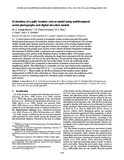Mostrar el registro sencillo del ítem
Evaluation of a gully headcut retreat model using multitemporal aerial photographs and digital elevation models
| dc.creator | Campo-Bescós, Miguel | es_ES |
| dc.creator | Flores Cervantes, J. H. | es_ES |
| dc.creator | Bras, R. L. | es_ES |
| dc.creator | Casalí Sarasíbar, Javier | es_ES |
| dc.creator | Giráldez Cervera, Juan Vicente | es_ES |
| dc.date.accessioned | 2018-11-27T11:22:20Z | |
| dc.date.available | 2018-11-27T11:22:20Z | |
| dc.date.issued | 2013 | |
| dc.identifier.issn | 2169-9011 | |
| dc.identifier.uri | https://hdl.handle.net/2454/31500 | |
| dc.description.abstract | A large fraction of soil erosion in temperate climate systems proceeds from gully headcut growth processes. Nevertheless, headcut retreat is not well understood. Few erosion models include gully headcut growth processes, and none of the existing headcut retreat models have been tested against long-term retreat rate estimates. In this work the headcut retreat resulting from plunge pool erosion in the Channel Hillslope Integrated Landscape Development (CHILD) model is calibrated and compared to long-term evolution measurements of six gullies at the Bardenas Reales, northeast Spain. The headcut retreat module of CHILD was calibrated by adjusting the shape factor parameter to fit the observed retreat and volumetric soil loss of one gully during a 36 year period, using reported and collected field data to parameterize the rest of the model. To test the calibrated model, estimates by CHILD were compared to observations of headcut retreat from five other neighboring gullies. The differences in volumetric soil loss rates between the simulations and observations were less than 0.05 m3 yr-1, on average, with standard deviations smaller than 0.35 m3 yr-1. These results are the first evaluation of the headcut retreat module implemented in CHILD with a field data set. These results also show the usefulness of the model as a tool for simulating long-term volumetric gully evolution due to plunge pool erosion. | en |
| dc.description.sponsorship | This work was made possible by financial support from the Spanish Ministry of Science and Technology, through the research project CGL2007-63453/HID, the Department of Education of the Government of Navarra, and the Public University of Navarra, with a fellowship awarded to the first author. CHILD development was supported by the U.S. Army Research Office (agreement DAAD 19-01-1-0513) and through the NSF grant (EAR 0642550). | en |
| dc.format.extent | 15 p. | |
| dc.format.mimetype | application/pdf | en |
| dc.language.iso | eng | en |
| dc.publisher | American Geophysical Union | en |
| dc.publisher | Wiley | en |
| dc.relation.ispartof | Journal of Geophysical Research: Earth Surface, vol. 118, 2159–2173 | en |
| dc.rights | ©2013. American Geophysical Union. All Rights Reserved. | en |
| dc.subject | Gully headcut retreat | en |
| dc.subject | Channel Hillslope Integrated Landscape Development (CHILD) model | en |
| dc.title | Evaluation of a gully headcut retreat model using multitemporal aerial photographs and digital elevation models | en |
| dc.type | info:eu-repo/semantics/article | en |
| dc.type | Artículo / Artikulua | es |
| dc.contributor.department | Proyectos e Ingeniería Rural | es_ES |
| dc.contributor.department | Landa Ingeniaritza eta Proiektuak | eu |
| dc.rights.accessRights | info:eu-repo/semantics/openAccess | en |
| dc.rights.accessRights | Acceso abierto / Sarbide irekia | es |
| dc.identifier.doi | 10.1002/jgrf.20147 | |
| dc.relation.publisherversion | https://doi.org/10.1002/jgrf.20147 | |
| dc.type.version | info:eu-repo/semantics/publishedVersion | en |
| dc.type.version | Versión publicada / Argitaratu den bertsioa | es |
| dc.contributor.funder | Gobierno de Navarra / Nafarroako Gobernua | es |
| dc.contributor.funder | Universidad Pública de Navarra / Nafarroako Unibertsitate Publikoa | es |


